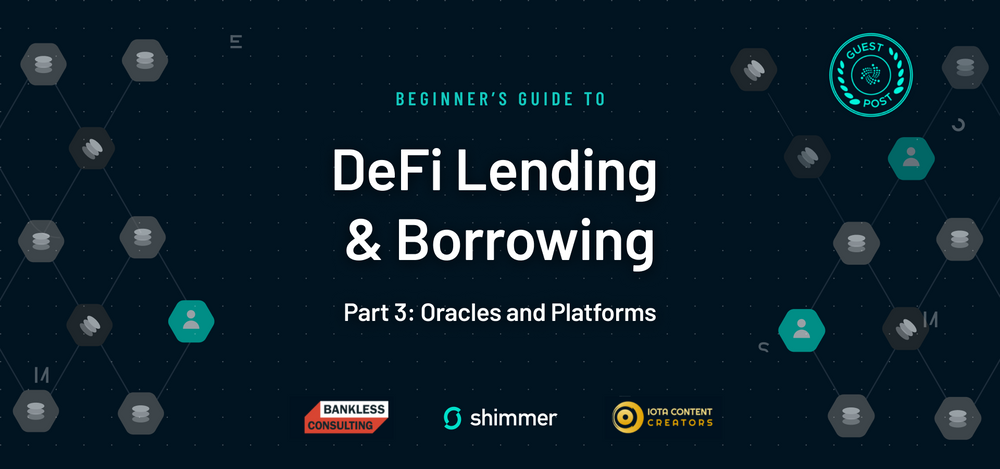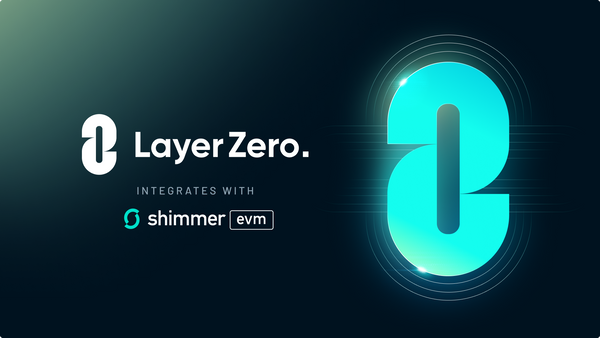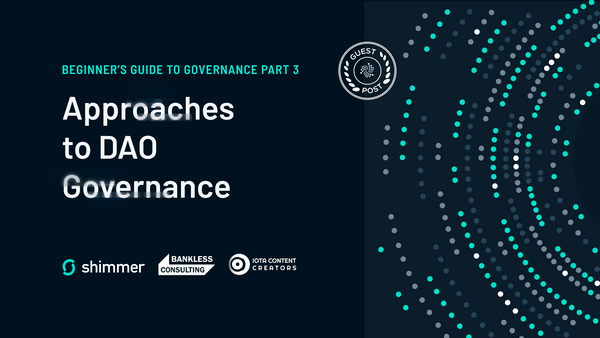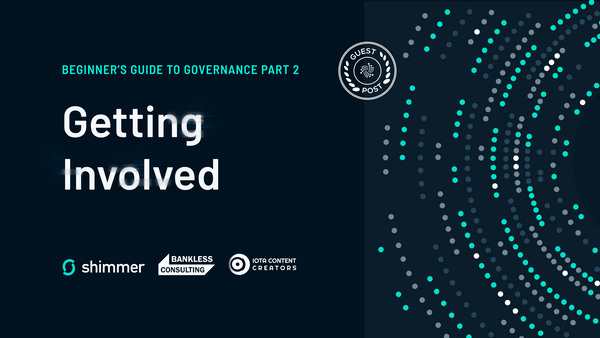Introduction to DeFi Lending & Borrowing: Part 3
Oracles and Platforms
TL;DR:
This final part of our introduction to DeFi borrowing and lending looks at the role of Oracles and platforms in DeFi lending and borrowing. Oracles play a crucial role by providing accurate market prices. AAVE is a trusted DeFi platform offering variable and fixed rates across multiple networks. Maker DAO is the first DeFi protocol and issuer of DAI stablecoin, operating on Ethereum with over-collateralized loans. Alchemix introduces self-repaying loans and synthetic tokens, allowing borrowers to generate yield on deposited assets.
The role of oracles in DeFi lending and borrowing is crucial for obtaining accurate market prices of assets. The final part of our introduction to DeFi borrowing and lending delves into the significance of oracles and introduces three prominent DeFi lending platforms: AAVE, Maker DAO, and Alchemix, highlighting their unique features and approaches to lending and borrowing in the decentralized finance ecosystem.
Oracles
DeFi protocols use price oracles to get the market price of assets. These oracles provide protocols with the prices they need to execute transactions. Chainlink is the leading price oracle used by most DeFi protocols, but Maker DAO, for instance, uses multiple streams of price oracles to ensure the accuracy of the prices. This is important because if there was a problem with Chainlink, for example, and the price of Ether was reported to be half of its current value, many borrowers would suddenly get liquidated. So price oracles are extremely important and it is recommended that you familiarize yourself with the oracles used by the platforms you are considering to ensure that they are using more than one reputable source.
Platforms
Now that we have discussed the process of DeFi lending and borrowing and listed the pros and cons when compared to TradFi, we can explore several different platforms to see how they work and learn about their unique features.
AAVE (https://aave.com) is a simple money market fund and is considered one of the most trusted DeFi primitives. It was created in 2017 as a product protocol called Etherlend before rebranding to AAVE in 2020. AAVE is the Finnish word for ‘ghost’, and the platform is transparent but also anonymous. Large investors, such as Mark Cuban and A16Z, have invested in this platform. AAVE operates on multiple networks including Ethereum, Avalanche, Optimism, Polygon, Arbitrum, AAVE Arc, and more.
Users can supply or borrow assets on these networks and, if they choose to borrow, can choose variable or fixed rates. Interest rates vary depending on the network and the type of asset being supplied or borrowed, but there is no fixed date to return the capital. The variable loan rates are calculated algorithmically based on the demand for a certain asset and can change over time. The stable rate can give you peace of mind knowing that your interest rate will never increase, while the variable rate can potentially give you a lower rate upfront but carries the risk that it will increase over time.
Maker DAO (https://makerdao.com), the first DeFi protocol created, was originally theorized in 2014 and put into practice in 2017. It is the issuer of DAI, an over-collateralized stablecoin, and the inventor of the multi-collateral DAI vaults.
Maker DAO is a decentralized autonomous organization (DAO) built on Ethereum that allows users to create and manage the DAI stablecoin. Unlike centralized stablecoins such as USDT or USDC, DAI is over-collateralized, meaning that users need to put up more collateral than the value of the DAI they want to create. Maker DAO’s system is designed to maintain the value of DAI at 1 US dollar, and users can borrow DAI against their collateral at a certain collateralization ratio.
Maker DAO’s assets are approved by Maker governance and the platform allows for a wide variety of collateral types, including ETH, Bitcoin, Link, Uni, and more. Users deposit their chosen collateral into a digital vault and borrow DAI against it. Unlike Aave, where there are lenders on the other side, Maker DAO is the lender and creates DAI by printing it.
One of the main goals of Maker is to become the backbone of many lending protocols. Various platforms, including Oasis, use Maker as their backend. Maker DAO has two tokens: the governance token, MKR, and the stablecoin, DAI.
If you need liquidity, you can enter into an over-collateralized loan by borrowing against your deposited assets, such as ETH. You can withdraw the borrowed DAI into your bank account to pay your bills or use it to buy other assets or engage in arbitrage. Depositing DAI into other lending or borrowing platforms can earn you a return of around 5% to 6%. Maker DAO charges fees, which are used to pay for its operating expenses, including the payroll for various core units that operate inside the platform such as handling price Oracle feeds, governance, and delegates.
If a user’s collateral falls below a certain threshold, Maker DAO will automatically liquidate their collateral to cover the debt by utilizing a third-party actor called a keeper. For example, imagine a user has 300 USD in collateral and borrows 185 USD worth of DAI, and the stability fee and liquidation threshold are set at 5 USD; then, if the value of their collateral drops below 190 USD, Maker DAO will offer the collateral to keepers who bid on the assets. The winning keeper uses their funds to cover the debt. The user will keep their DAI, and the keeper gets the collateral at a slightly lower price than the market value to profit on the spread. These days, most keepers are bots.
Maker governance is decentralized and anyone can participate in it by holding MKR tokens. The governance process is known as “maker improvement proposals” (MIPs) and anyone can submit a MIP. The community then votes on the proposal and if it receives enough support, it can be implemented into the system. This decentralized governance model is one of the key features of Maker and allows for a more democratic approach to decision-making.
Another important aspect of Maker is its stability fee. This is a fee that is charged on outstanding DAI loans and is intended to help maintain the peg to the US dollar. The stability fee is set by Maker governance and is adjusted based on market conditions. If the DAI price is trading above 1 US dollar, the stability fee is increased, while if the DAI price is trading below 1 US dollar, the stability fee is decreased. This system helps to ensure that DAI remains stable and maintains its peg to the US dollar.
Maker has been very successful in terms of DeFi adoption. DAI is one of the most widely-used stablecoins in DeFi and is used as collateral in many different lending and borrowing protocols. Maker has also been adopted as the backend for many other protocols, further increasing its reach and influence in the ecosystem.
Alchemix (https://alchemix.fi) is a DeFi lending and borrowing platform known for introducing self-repaying loans and synthetic tokens. Similar to Maker, Alchemix operates as an over-collateralized borrowing platform and lending protocol. It offers vaults and farms as different yield strategies to generate interest on deposited assets. Unlike traditional loans where borrowers pay interest and have a fixed repayment date, Alchemix’s self-repaying loans pay borrowers interest and have no fixed repayment date. The interest is paid through a yield strategy deployed on the deposited assets.
The amount that can be borrowed at any given time (known as the debt ceiling) fluctuates based on the utilization ratio and the available collateral. Alchemix has various strategies that offer different interest rates for different crypto assets. When borrowers deposit assets into a yield strategy paying, for example, a 2% interest rate, they can borrow up to 50% of the deposited asset’s value. However, the interest repayment only occurs on the portion of the deposit that remains in the vault, not on the borrowed amount. This means that if a borrower deposited 100 USD and borrowed 50 USD, they would only receive interest on 50 USD of their deposit. With interest at one percent, it would take approximately 100 years to repay the loan if half of the deposit was borrowed (not considering compounding for simplicity). However, it’s worth noting that the purpose of self-repaying loans on Alchemix is not necessary to fully repay the loan but to generate yield on the deposited assets while maintaining exposure to the borrowed funds.
One notable feature of Alchemix is the ability to withdraw funds once the interest on the loan has repaid itself or manually repay the debt. Unlike Maker DAO, borrowers have the option to self-liquidate their loans. By pressing a button, the system will sell the borrower’s collateral equivalent to the borrowed amount, allowing them to close the loan and retrieve their collateral.
Alchemix also utilizes synthetic assets, which are tokenized derivatives. For example, Alchemix takes ETH and issues an Al-ETH token that represents the locked ETH within the platform. This token allows borrowers to trade and borrow against its value, knowing that it can always be swapped back to regular ETH. Synthetic assets provide a transparent way to track assets within the system and facilitate borrowing and trading.
(In TradFi markets, derivatives can be complex and pose risks to the global financial system. There are many different types of derivatives and they’re extremely complicated if you’re not familiar with them. However, in the blockchain space, derivatives are transparent, enabling better oversight and safety. This transparency allows users to monitor the issuance and movement of derivatives, mitigating concerns about potential risks to the financial system.)
Conclusion
This concludes our introduction to lending and borrowing in DeFi. Despite the notable risks associated with DeFi lending and borrowing, there are still plenty of reasons to engage in these financial markets. As we argued in Part 2, DeFi lending and borrowing is transparent, permissionless, available to everyone, and promotes equality – there are no biases towards genders, races, or religions; as long as someone has the funds, they can borrow.
New innovations are being tested daily, so the DeFi options for lending and borrowing may soon surpass other traditional options. However, as always, doing one’s own research before engaging with any aspect of DeFi is paramount.
Introduction to DeFi Lending and Borrowing
Part 1: The Essentials
Part 2: DeFi Lending and Borrowing Pros and Cons
Part 3: Oracles and Platforms
Also in this series
Beginner's Guide to Crypto Wallets
Beginners Guide to DEX vs. CEX
Beginner's Guide to DeFi Lending & Borrowing
Beginner's Guide to Yield Farming



